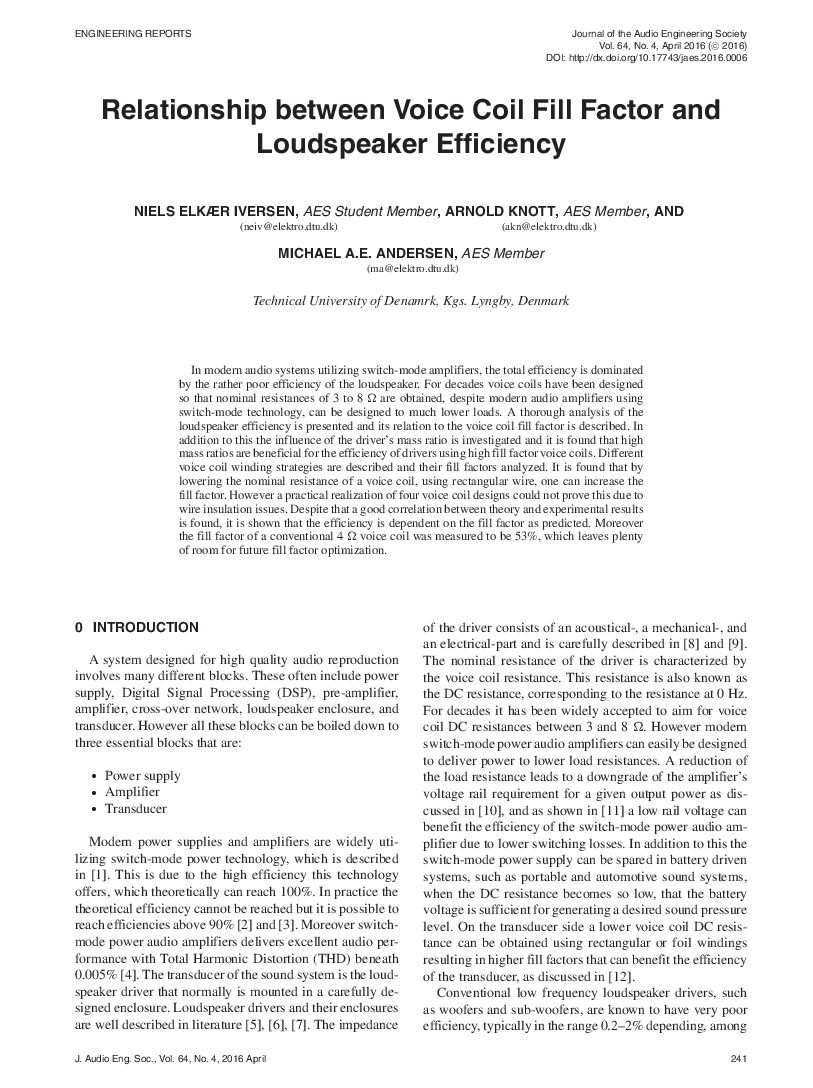Home / Publications / E-library page
You are currently logged in as an
Institutional Subscriber.
If you would like to logout,
please click on the button below.
Home / Publications / E-library page
Only AES members and Institutional Journal Subscribers can download
For decades voice coils have been designed for a nominal resistance of 3 to 8 ohms, despite the fact that modern audio amplifiers using switch-mode technology can be easily handle much lower impedance loads. A thorough analysis of loudspeaker efficiency showed that the efficiency can be expressed as a function of the voice coil fill factor and the geometry of the magnet system. In addition, high mass ratios are more beneficial for the efficiency of drivers using high fill factor voice coils than drivers with low mass ratio. Different voice coil winding strategies are described and their fill factors analyzed. It is found that by lowering the nominal resistance of a voice coil using rectangular wire, one can increase the fill factor. A higher fill factor will shift the low frequency upward, resulting in higher -3 dB cut-off frequencies. By using rectangular wire with low DC resistance, the fill factor could be significantly increased. The fill factor of a conventional 4-ohm voice coil was measured to be 53%.
Author (s): Iversen, Niels Elkjær; Knott, Arnold; Andersen, Michael A. E.
Affiliation:
Technical University of Denmark, Kgs. Lyngby, Denmark
(See document for exact affiliation information.)
Publication Date:
2016-04-06
Import into BibTeX
Permalink: https://aes2.org/publications/elibrary-page/?id=18132
(368KB)
Click to purchase paper as a non-member or login as an AES member. If your company or school subscribes to the E-Library then switch to the institutional version. If you are not an AES member Join the AES. If you need to check your member status, login to the Member Portal.

Iversen, Niels Elkjær; Knott, Arnold; Andersen, Michael A. E.; 2016; Relationship between Voice Coil Fill Factor and Loudspeaker Efficiency [PDF]; Technical University of Denmark, Kgs. Lyngby, Denmark; Paper ; Available from: https://aes2.org/publications/elibrary-page/?id=18132
Iversen, Niels Elkjær; Knott, Arnold; Andersen, Michael A. E.; Relationship between Voice Coil Fill Factor and Loudspeaker Efficiency [PDF]; Technical University of Denmark, Kgs. Lyngby, Denmark; Paper ; 2016 Available: https://aes2.org/publications/elibrary-page/?id=18132
@article{iversen2016relationship,
author={iversen niels elkjær and knott arnold and andersen michael a. e.},
journal={journal of the audio engineering society},
title={relationship between voice coil fill factor and loudspeaker efficiency},
year={2016},
volume={64},
issue={4},
pages={241-252},
month={april},}